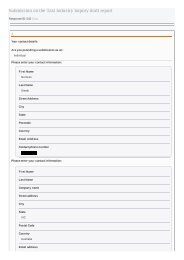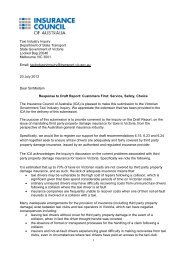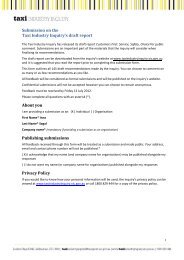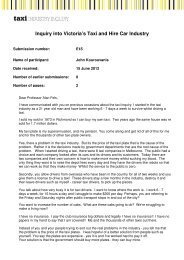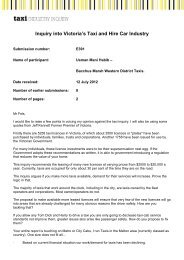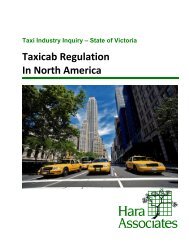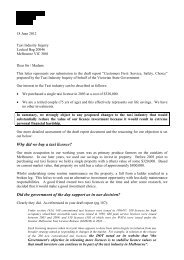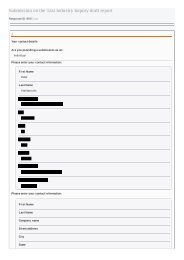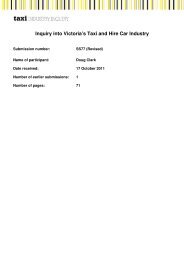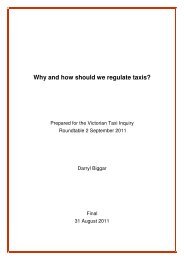Part D â Understanding and improving industry performance (PDF ...
Part D â Understanding and improving industry performance (PDF ...
Part D â Understanding and improving industry performance (PDF ...
Create successful ePaper yourself
Turn your PDF publications into a flip-book with our unique Google optimized e-Paper software.
A further summary of these data is provided in Table<br />
10.5. This indicates that 15 per cent of trips involve some<br />
form of ‘dead running’ beginning or ending outside of<br />
the zone. Further analysis of these data reveals that 5.9<br />
per cent of trips taken with taxis affiliated with Frankston<br />
start a journey in the outer suburban zone <strong>and</strong> finish<br />
in the metropolitan zone; this applies to 8 per cent of<br />
D<strong>and</strong>enong taxis’ trips. These data suggest that there<br />
would be some immediate efficiency benefits from<br />
merging the two zones, as taxis would no longer need to<br />
run back empty.<br />
Table 10.5 Overall outer suburban trip zone start <strong>and</strong><br />
end zone statistics<br />
Trip type<br />
Beginning inside the outer suburban zone <strong>and</strong><br />
ending outside the outer suburban zone<br />
Beginning outside the outer suburban zone<br />
<strong>and</strong> ending inside the outer suburban zone<br />
Beginning <strong>and</strong> ending wholly inside the outer<br />
suburban zone<br />
Beginning <strong>and</strong> ending wholly outside the outer<br />
suburban zone<br />
Total proportion of trips either beginning or<br />
ending outside the outer suburban zone<br />
Source: TII<br />
% of total<br />
12.4%<br />
1.3%<br />
85%<br />
1.3%<br />
15%<br />
This does not account for the number of trip refusals<br />
by taxis that refuse to go out of zone. There does not<br />
appear to be any way to measure this effect, although<br />
a submission by Frankston taxis suggests that dead<br />
running is a problem for metropolitan zone taxis that<br />
refuse to service Frankston-bound fares. 94<br />
The benefits from zoning are often couched in terms of<br />
better service. This argument only has force if zones were<br />
amalgamated <strong>and</strong> there were very different licence values<br />
between the two merged zones. That is because vehicles<br />
will tend to work more in the area with the higher licence<br />
value (indicating greater profitability), leaving the other zone<br />
area less well served than before. Of course, any drop in<br />
service could also be addressed with the release of more<br />
licences until the profits available in each area are similar.<br />
The inquiry notes that licence <strong>and</strong> assignment values<br />
(profits) that may be earned in servicing outer suburban<br />
zones are not substantially less than those earned in<br />
servicing the metropolitan zone. Data from the VTD<br />
indicates that, in 2011, average assignment fees per<br />
month in the outer suburban zone were within 20 per<br />
cent of those recorded in the metropolitan zone (around<br />
$25,000 compared to $30,500 in metropolitan areas) <strong>and</strong><br />
licence prices were over $430,000 in the outer suburban<br />
zone. This suggests that removing the zone will not<br />
cause many (if any) taxis to seek work outside the outer<br />
suburban zone.<br />
Equally, the inquiry notes that a similar case could be<br />
made with respect to the Western Port <strong>and</strong> Port Philip<br />
zones, where the last recorded licence sales were in<br />
excess of $300,000. During discussions with Peninsula<br />
Taxis, the inquiry was advised that licences are now<br />
considered to have a value as high as $800,000 in the<br />
Mornington Peninsula zones.<br />
There is some <strong>performance</strong> data that shows that the<br />
‘overall satisfaction’ of consumers is higher for Frankston<br />
<strong>and</strong> D<strong>and</strong>enong taxis. The DOT surveys of satisfaction<br />
have generally found higher ratings for these services:<br />
Analysis, using the last 12 months of data, revealed<br />
that Frankston Taxis <strong>and</strong> D<strong>and</strong>enong Taxis continued<br />
to receive the highest ratings by taxi travellers (78.1<br />
<strong>and</strong> 71.7 respectively, on the 0-to-10 scale), whilst<br />
the two most widely used taxi companies, i.e. Yellow<br />
Cabs <strong>and</strong> Silver Top Taxis, received the lowest ratings<br />
(64.8 <strong>and</strong> 62.4 respectively). 95<br />
The inquiry notes that this service <strong>performance</strong> does not<br />
imply that amalgamation of the zone will lessen such<br />
<strong>performance</strong>. Current superior <strong>performance</strong> does not<br />
necessarily demonstrate that amalgamating the zone<br />
will cause worse <strong>performance</strong> within the old zone area.<br />
In fact, there are three reasons to expect that there will<br />
be no deterioration in <strong>performance</strong> <strong>and</strong> that service<br />
<strong>performance</strong> could in fact improve:<br />
• The similarity of licence values between the zones<br />
indicates that vehicles affiliated to the Frankston <strong>and</strong><br />
D<strong>and</strong>enong networks will not have a major incentive<br />
to work solely outside these areas.<br />
• There should be a relatively equal number of vehicles<br />
that come into the Frankston <strong>and</strong> D<strong>and</strong>enong areas<br />
for fares as leave these areas for fares terminating in<br />
the current metropolitan zone.<br />
• Finally, it is not obvious why the advantages of NSPs<br />
in the outer suburban zones will not remain a source<br />
of competitive advantage over the metropolitan zone<br />
NSPs. Increasing the scope for competition between<br />
NSPs in these areas should benefit customers.<br />
94 Frankston Radio Taxis Pty Ltd (2009), Review of the Boundaries of the<br />
Frankston Taxi Zone – Submission to the Victorian Taxi Directorate,<br />
provided to the Taxi Industry Inquiry by the VTD, p.11<br />
95 Wallis (2010), Op. Cit.<br />
<strong>Underst<strong>and</strong>ing</strong> <strong>industry</strong> <strong>performance</strong> CUSTOMERS FIRST 211




